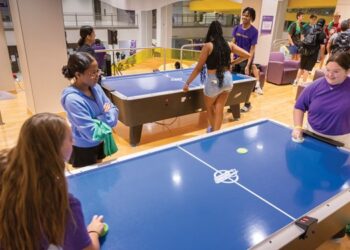The ubiquity of data is capturing the attention of professionals in every industry. And campus recreation professionals could certainly benefit from a data-driven picture of how students engage with campus rec spaces and equipment. Inspiration for new recreation facilities is driven by understanding your current and future needs and benchmarking against peer institutions. Can you imagine if you had not only more accurate and meaningful usage data of your own facilities, but also the ability to cross-reference that data with hundreds of other institutions around the country?
CORE, Connect2Concepts and Sasaki have partnered on a study to measure data on real-time space utilization from multiple collegiate recreation centers. A broad spectrum of institutions were included: University of Pennsylvania, Rowan University, Duke University and Elon University. Below are some initial considerations as you ramp up your data collection and sort it for meaningful feedback.
Yes, collecting data is essential. Data provides informed rationale for funding new programs, spaces, staffing or equipment, and can show realized return on investments. Data that proves a recreation program’s integral role in students’ lives and well-being is invaluable not only to campus recreation, but to the institution’s overall mission.
Yes, there is a recommended way of doing so. In this study, student employees at the various rec centers were given iPads equipped with Connect2 software to utilize throughout their shifts. This made the study efficient — digital natives were in control of familiar technology — and also required no additional or new staffing. Employees tracked the number of users to discern peak hours and equipment usage rates. Through computing this data, we can determine a facility’s “active capacity”— that is, the ideal number of users in relation to the available space and equipment. Applying active capacity as a performance indicator helps us understand space availability and potential service interruptions.
This applies to you, too. While the schools involved in the study vary greatly in terms of student body and campus size, there are a few universals that data access affords. Namely, rec directors can identify participation trends in real time, seeing the direct impact on utilization. This real-time support allows rec directors to anticipate what students may need next. Data can also improve operations and staffing decisions tremendously — and quickly.
Information is only as strong as the data that comprises it. The more informed the data, the more informed we can be in our decision making. As the pool of rec centers opting in to data collection continues to grow, the ability to cross reference this data at a larger scale provides a greater spectrum of decision-making ability across space type.
Bill Massey is the Sasaki sports practice leader. He can be reached at bmassey@sasaki.com. Jennifer Jacobs is the owner of Connect2Concepts. She can be reached at jjacobs@connect2concepts.com. Tamara Jarrett is the president of CORE Unlimited. She can be reached at tjarrett@coreunlimitedllc.com.










